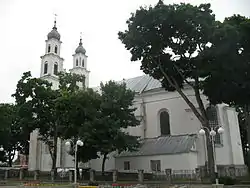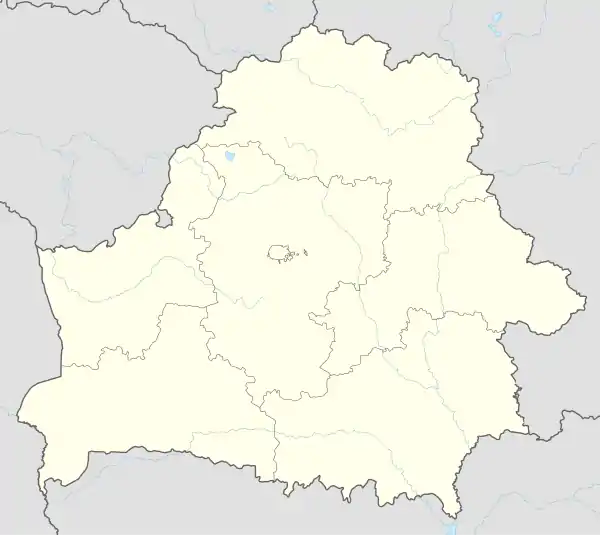Dzyatlava
Dziatlava or Dyatlovo (Belarusian: Дзятлава, Lithuanian: Zietela, Polish: Zdzięcioł, Russian: Дятлово, Yiddish: זשעטל Zhetl) is a town in Belarus in the Grodno oblast, about 165 km southeast of Grodno. The population was 7,700 in 2016.
Dziatlava/Zdzięcioł
Дзятлава | |
|---|---|
 Catholic Church of the Assumption of Mary founded by Sejm Marshal Lew Sapieha | |
 Flag  Coat of arms | |
 Dziatlava/Zdzięcioł Location of Dyatlovo | |
| Coordinates: 53°27′N 25°24′E | |
| Country Subdivision | Belarus Hrodna voblast |
| Founded | 1498 |
| Population (2004) | |
| • Total | 8 300 |
| Time zone | UTC+3 (FET) |
| • Summer (DST) | UTC+3 (not observed) |
| Area code(s) | +375-15 |
| Website | Dyatlovo Regional Executive Committee |
History
Dziatlava (Zdzięcioł) was first referenced in documents from 1498, when it was granted by the King of Poland John I Albert to Prince Konstanty Ostrogski of Polish–Lithuanian Commonwealth, who later built a wooden castle there. In the 17th century the settlement was owned by Lew Sapieha, who ordered a Catholic church to be erected on the main city square. The church was consecrated in 1646, renovated after a fire in 1743 and still stands.[1] During the Great Northern War of the anti-Swedish alliance, Peter I of Russia visited Dzyatlava and stayed there for a week in January 1708. In the 18th century, the town was owned by Polish magnate Stanisław Sołtyk, who built a Baroque residence there in 1751. After the partitioning of Poland, until the aftermath of World War I, the town was within the Russian Empire, in the Province of Grodno, district of Slonim.[2]
.jpg.webp)
Between World War I and World War II, Zdzięcioł (now Dziatlava) belonged to the eastern part of the Second Polish Republic. It was the seat of Gmina Zdzięcioł in Nowogródek Voivodeship.[3] The population was composed predominantly of Polish Jews. The Soviet forces invaded eastern Poland on September 17, 1939, and stationed in the Voivodeship area until the outbreak of their own war with Germany in June 1941. After the Soviet rapid retreat, and several months of Nazi ad hoc persecution, on February 22, 1942 the new German authorities officially created Zdzięcioł Ghetto.[4][5]
During the Holocaust, about 3,000–5,000 Zdzięcioł Jews were killed near the town during the Zdzięcioł massacres of 1942 by a German death squad aided by the Lithuanian and the Belarusian Auxiliary Police battalions.[6] The old Jewish cemetery is considered a minor landmark.
Lithuanian heritage
Being 80 kilometers south of present-day Lithuania, environs of Dzyatlava had been known by linguists as the outermost indigenous Lithuanian speaking "island" apart from the contiguous Lithuanian language territory. The Lithuanian-speakers spoke a unique dialect, known as the "Zietela dialect"; it has been speculated that the ancestors of its speakers might have been Lithuanized Jotvingians. It drew the attention by many prominent linguists, such as Christian Schweigaard Stang, Vladimir Toporov, Kazimieras Būga and Juozas Balčikonis. In 1886, 1156 people in nearby villages declared themselves Lithuanians, however the real number might have been much greater.[7] At present the Lithuanian population is virtually extinct.[7]
People
- Ivan Karizna, cellist
- Jacob ben Wolf Kranz of Dubno, the "Dubner maggid" (1741–1804)
- Yisrael Meir Kagan (Chofetz Chayim), 1839–1933
- Zvi Yosef Resnick, rabbi and rosh yeshivah (1841–1912)
- Mnachem Risikoff, rabbi and scholar (1866–1960), born in Dzyatlava
- Baruch Sorotzkin (1917-1979)
- Tamara Lazakovich, European All-Around Co-Champion (1971) and Olympic medalist (1972) in gymnastics
See also
- Dziatlava ghetto, see: Zdzięcioł Ghetto
- Zdzięcioł massacres, see Dzyatlava massacre
References
- Photographs, at globus.tut.by
- JewishGen Communities Database for Dzyatlava, Belarus
- "Województwo Nowogródzkie". Skorowidz miejscowości Rzeczypospolitej Polskiej - Tom VII - Część I. Warszawa: Główny Urząd Statystyczny Rzeczypospolitej Polskiej (Central Statistical Office of Poland). 1923.
- Holocaust Encyclopedia. "Zdzieciol (Zhetel) Ghetto" (Wikipedia OTRS ticket no. 2007071910012533). USHMM. Retrieved July 27, 2011.
- Piotr Eberhardt, Jan Owsinski (2003). Ethnic Groups and Population Changes in Twentieth-century Central-Eastern Europe: History, Data, Analysis. M.E. Sharpe. ISBN 978-0-7656-0665-5.
- Christian Gerlach (1999). Kalkulierte Morde: Die deutsche Wirtschafts- und Vernichtungspolitik in Weißrußland 1941 bis 1944 [Calculated Murder: The German economic and annihilation policy in Belorussia 1941 to 1944] (in German). Hamburger Edition, Hamburg. pp. 206, 614, 702. ISBN 3930908549.
- Gediminas Zemlickas, "Paminklas mirusiai ðnektai (2)" [Monument to the Extinct Dialect], Lietuviø kalbos instituto Kalbos istorijos ir dialektologijos skyriaus darbuotojai doc. dr. Danguolë Mikulënienë ir dr. Aloyzas Vidugiris. "Archived copy". Archived from the original on October 10, 2007. Retrieved 2008-01-23.CS1 maint: archived copy as title (link) CS1 maint: bot: original URL status unknown (link)
External links
| Wikimedia Commons has media related to Dziatlava. |
